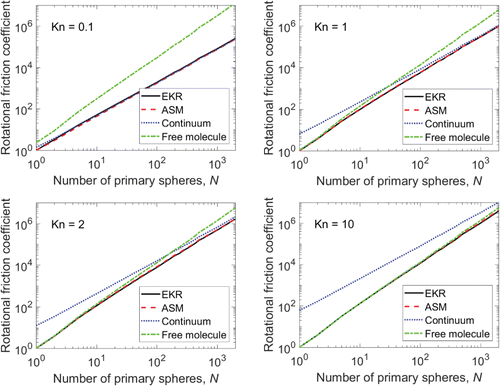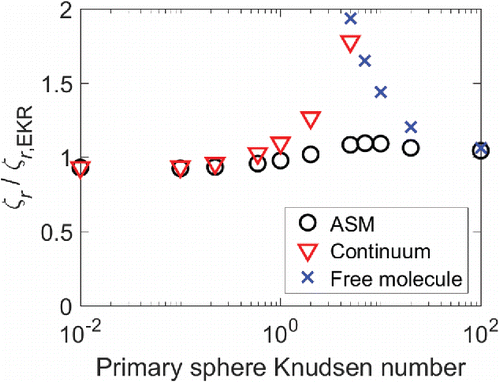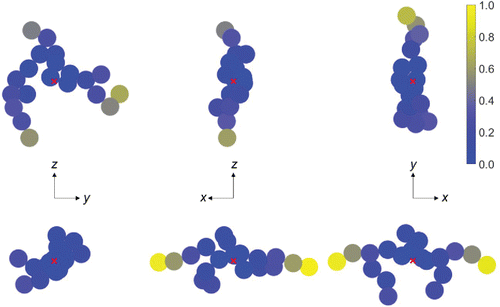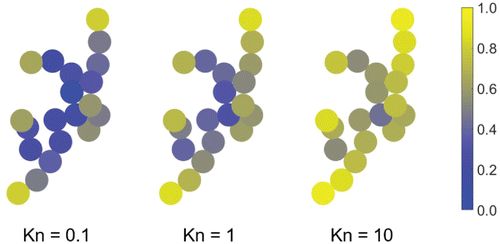Figures & data
Table 1. Comparison of EKR results to experimental data from Colbeck et al. (Citation1997).
Figure 1. Rotational friction coefficient results for Kn1 = 0.1, 1, 2, and 10. Results are normalized by the monomer rotational friction coefficient for each Knudsen number.

Figure 2. Ratio of the rotational friction coefficients for N = 2000 calculated using the rotational adjusted sphere method and in the continuum and free molecule limits to the rotational friction coefficient calculated using the EKR method.

Figure 3. Ratio of the characteristic translational diffusion time to the characteristic rotational diffusion time for DLCA aggregates as a function of primary sphere size and the number of primary spheres. Each curve represents the results for the specified primary sphere Knudsen number. The plot on the left shows results of our EKR calculations, while the plot on the right shows results obtained using our analytic fits for the translational and rotational friction coefficients (Equations Equation(25)[25]
[25] and (Equation26
[26]
[26] )).
![Figure 3. Ratio of the characteristic translational diffusion time to the characteristic rotational diffusion time for DLCA aggregates as a function of primary sphere size and the number of primary spheres. Each curve represents the results for the specified primary sphere Knudsen number. The plot on the left shows results of our EKR calculations, while the plot on the right shows results obtained using our analytic fits for the translational and rotational friction coefficients (Equations Equation(25)[25] ζ6πμ a=1+1.612Kn1Cc(Kn1){[0.852N0.535+0.148]−1+1.612Kn1[0.843N0.939+0.157]−1}−1[25] and (Equation26[26] ζr8πμ a3=1+5.988Kn1Cr(Kn1){[0.713N1.63+0.287]−1+5.988Kn1[1.184N2.02−0.184]−1}−1[26] )).](/cms/asset/04df310a-272e-4a0c-9cd2-8853c00acc11/uast_a_1390544_f0003_oc.gif)
Figure 4. Torque on each sphere of two 20-particle aggregates rotating about the x-, y-, and z-axes (left, middle, and right, respectively) for Kn1 = 10. The rotation axis is out of the page. The torque is normalized by the maximum torque among the six cases. The rotational friction coefficient for aggregate 2 (bottom) is approximately 75% of the rotational friction coefficient for aggregate 1 (top).

Figure 5. Ratio of the drag on each sphere in a 20-particle aggregate to the drag on an isolated sphere (i.e., the monomer momentum shielding factor). Here, the particle is rotating counter-clockwise. A value of unity indicates that the sphere behaves as if it is isolated, while a value near zero indicates that the perturbations caused by the other spheres have a significant impact on the drag.

Figure 6. Error in our analytical expression for the rotational friction coefficient (Equation Equation(26)[26]
[26] ) relative to our EKR results. This error is defined by Equation Equation(27)
[27]
[27] .
![Figure 6. Error in our analytical expression for the rotational friction coefficient (Equation Equation(26)[26] ζr8πμ a3=1+5.988Kn1Cr(Kn1){[0.713N1.63+0.287]−1+5.988Kn1[1.184N2.02−0.184]−1}−1[26] ) relative to our EKR results. This error is defined by Equation Equation(27)[27] error=ζrfit−ζrEKRζrEKR[27] .](/cms/asset/af0a5f39-fa85-4dec-9764-539b4688f784/uast_a_1390544_f0006_oc.gif)
